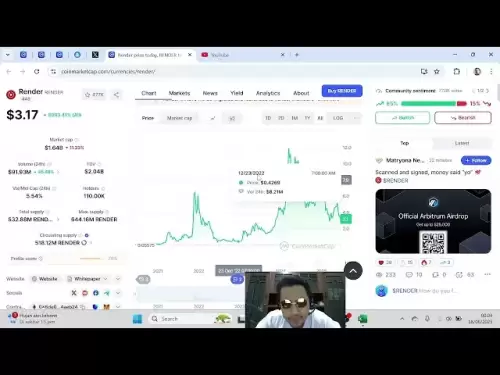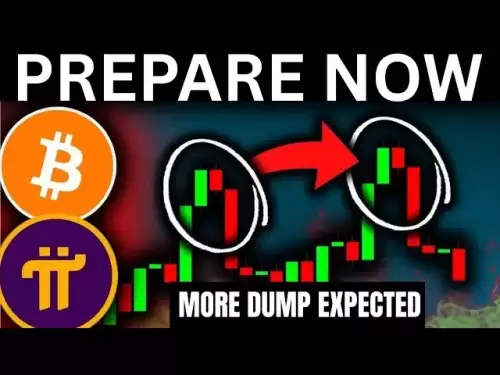-
 Bitcoin
Bitcoin $106,754.6083
1.33% -
 Ethereum
Ethereum $2,625.8249
3.80% -
 Tether USDt
Tether USDt $1.0001
-0.03% -
 XRP
XRP $2.1891
1.67% -
 BNB
BNB $654.5220
0.66% -
 Solana
Solana $156.9428
7.28% -
 USDC
USDC $0.9998
0.00% -
 Dogecoin
Dogecoin $0.1780
1.14% -
 TRON
TRON $0.2706
-0.16% -
 Cardano
Cardano $0.6470
2.77% -
 Hyperliquid
Hyperliquid $44.6467
10.24% -
 Sui
Sui $3.1128
3.86% -
 Bitcoin Cash
Bitcoin Cash $455.7646
3.00% -
 Chainlink
Chainlink $13.6858
4.08% -
 UNUS SED LEO
UNUS SED LEO $9.2682
0.21% -
 Avalanche
Avalanche $19.7433
3.79% -
 Stellar
Stellar $0.2616
1.64% -
 Toncoin
Toncoin $3.0222
2.19% -
 Shiba Inu
Shiba Inu $0.0...01220
1.49% -
 Hedera
Hedera $0.1580
2.75% -
 Litecoin
Litecoin $87.4964
2.29% -
 Polkadot
Polkadot $3.8958
3.05% -
 Ethena USDe
Ethena USDe $1.0000
-0.04% -
 Monero
Monero $317.2263
0.26% -
 Bitget Token
Bitget Token $4.5985
1.68% -
 Dai
Dai $0.9999
0.00% -
 Pepe
Pepe $0.0...01140
2.44% -
 Uniswap
Uniswap $7.6065
5.29% -
 Pi
Pi $0.6042
-2.00% -
 Aave
Aave $289.6343
6.02%
What is the liquidity of OKX Exchange?
OKX's liquidity, while seemingly high due to reported trading volume, requires deeper analysis of order book depth and slippage to accurately assess, as various factors influence it.
Mar 12, 2025 at 07:36 am
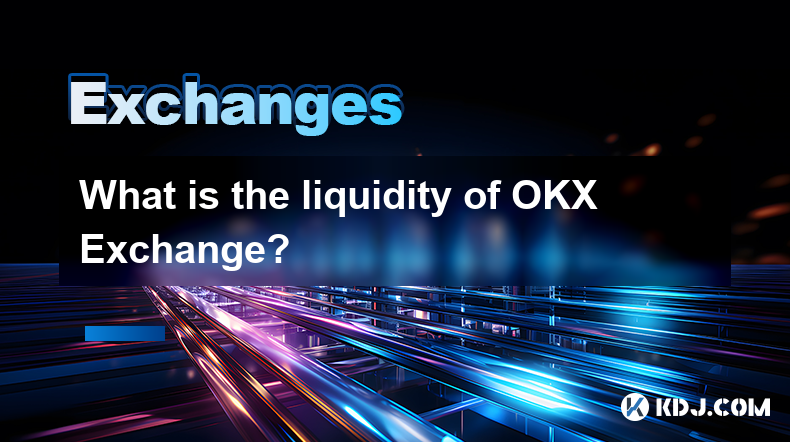
What is the Liquidity of OKX Exchange?
Key Points:
- OKX's liquidity is a complex issue, influenced by various factors including trading volume, order book depth, and the overall market conditions. It's not a single, easily quantifiable number.
- While OKX boasts high trading volumes, assessing true liquidity requires a deeper dive into order book analysis and understanding the potential for slippage.
- Factors like the specific trading pair, time of day, and market volatility significantly impact perceived liquidity on the exchange.
- Comparing OKX's liquidity to other exchanges requires careful consideration of methodologies and potential biases in data reporting.
- Regulatory environment and the exchange's risk management practices indirectly influence liquidity by affecting trader confidence and participation.
Understanding OKX Exchange Liquidity:
Liquidity in the context of a cryptocurrency exchange like OKX refers to the ease with which an asset can be bought or sold without significantly impacting its price. A highly liquid exchange allows traders to execute large orders quickly at prices close to the current market price. Conversely, an illiquid exchange may experience significant price slippage (the difference between the expected price and the actual execution price) when large orders are placed, particularly in less actively traded pairs.
- Trading Volume as an Indicator (But Not the Whole Story): OKX consistently reports high trading volumes, often ranking among the top exchanges globally. High volume generally suggests significant liquidity, as it implies a large number of buyers and sellers actively participating in the market. However, trading volume alone is an insufficient measure of liquidity. A high volume could be driven by wash trading (artificial inflation of trading volume), or it might represent a small number of very large trades rather than a broad base of active participants. Genuine liquidity requires a deep and balanced order book, capable of absorbing substantial buy and sell orders without significant price movement. Simply looking at the overall trading volume doesn't provide a complete picture of OKX's liquidity across different assets and trading pairs. For example, a high volume in Bitcoin/USDT might not translate to equivalent liquidity in a smaller-cap altcoin trading pair on the same exchange. Furthermore, reported trading volume can be subject to manipulation and should be viewed cautiously. Independent verification of volume data is crucial for a complete understanding. To truly understand the depth of OKX's liquidity, one needs to analyze the order book, which reveals the precise number of buy and sell orders at various price points. A deep and balanced order book, with significant volume at prices close to the mid-price, is a much more reliable indicator of genuine liquidity than overall trading volume alone. This is because a deep order book indicates the presence of many buyers and sellers willing to trade at prices close to the current market price, minimizing the risk of price slippage. The lack of transparency regarding the order book depth in some exchanges makes accurate assessment of liquidity even more challenging.
- Order Book Depth and Bid-Ask Spread Analysis: A critical aspect of assessing OKX's liquidity lies in examining the depth of its order book. The order book displays the pending buy and sell orders at different price levels. A deep order book, characterized by a large number of buy and sell orders at various price levels close to the market price, indicates high liquidity. Conversely, a shallow order book, with few orders at or near the market price, suggests low liquidity. The bid-ask spread, the difference between the highest buy order (bid) and the lowest sell order (ask), is another key indicator. A narrow bid-ask spread suggests high liquidity, while a wide spread indicates low liquidity. Analyzing the order book for specific trading pairs at different times of day provides a more nuanced understanding of OKX's liquidity. Market conditions such as high volatility can significantly affect order book depth and the bid-ask spread, leading to temporary fluctuations in liquidity. Therefore, a comprehensive liquidity assessment requires observing the order book over time and under various market conditions. Furthermore, sophisticated algorithms and high-frequency trading (HFT) can impact the order book dynamics, making it challenging to accurately interpret its depth as a measure of true liquidity. The presence of large hidden orders (orders not visible on the public order book) further complicates the analysis, as these orders can significantly affect the actual liquidity available for execution.
- Slippage and Order Execution Speed: Slippage, the difference between the expected price and the actual execution price of a trade, is a direct consequence of liquidity. High liquidity generally leads to low slippage, as large orders can be executed quickly at prices close to the market price. Conversely, low liquidity results in high slippage, especially for larger orders. Measuring slippage on OKX requires analyzing the execution prices of trades, comparing them to the prevailing market price at the time of order placement. This analysis should be performed across different trading pairs and order sizes to obtain a comprehensive understanding of the impact of liquidity on order execution. Order execution speed is another crucial factor. In a highly liquid market, orders are executed almost instantaneously. However, in a less liquid market, there might be significant delays in order execution, especially for larger trades. Monitoring order execution times on OKX, across various trading pairs and order sizes, can provide valuable insights into its liquidity. It's important to consider the trading interface and the technology used by OKX, as these can influence order execution speed. Factors such as network latency and the exchange's matching engine can affect the speed of order execution. A comprehensive assessment of liquidity on OKX requires examining both slippage and order execution speed.
- Comparison with Other Exchanges: Comparing OKX's liquidity to other major cryptocurrency exchanges requires careful consideration of the methodologies used for data collection and analysis. Different exchanges may report trading volumes and other liquidity metrics differently, making direct comparisons challenging. Furthermore, the specific trading pairs and assets considered can also significantly affect the results. A direct comparison of overall trading volume might be misleading, as the specific assets and trading pairs offered on each exchange vary considerably. A more robust comparison would involve analyzing the order book depth, bid-ask spreads, slippage, and order execution speed for similar trading pairs across different exchanges. The time of day and market conditions should also be carefully considered, as these factors can significantly impact liquidity on all exchanges. Finally, the credibility and transparency of data reporting by different exchanges must be considered. Some exchanges may be more transparent than others in reporting their liquidity metrics, making it crucial to critically assess the reliability of the data before making comparisons.
- Regulatory Environment and Risk Management: The regulatory environment and the exchange's risk management practices indirectly influence liquidity by affecting trader confidence and participation. A well-regulated exchange with robust risk management measures is more likely to attract traders, leading to increased liquidity. Conversely, a poorly regulated exchange or one with inadequate risk management practices may experience lower liquidity due to reduced trader confidence. The regulatory landscape for cryptocurrency exchanges is constantly evolving, and changes in regulations can significantly impact liquidity. The exchange's approach to KYC/AML (Know Your Customer/Anti-Money Laundering) compliance and its security measures can also influence trader confidence and, consequently, liquidity. Furthermore, the exchange's handling of potential security breaches or other crises can significantly affect its reputation and liquidity. Therefore, assessing OKX's liquidity requires considering not only its trading volume and order book depth but also the regulatory environment and its risk management practices.
FAQs:
Q: How is OKX's liquidity compared to Binance or Coinbase?
A: Direct comparisons are difficult due to differences in reporting methodologies and the specific assets traded. While OKX often reports high trading volumes, analyzing order book depth, bid-ask spreads, and slippage across comparable trading pairs on all three exchanges would be necessary for a meaningful comparison.
Q: Does OKX liquidity vary across different cryptocurrency pairs?
A: Yes, significantly. Liquidity is generally higher for major cryptocurrencies like Bitcoin and Ethereum and lower for less popular or newer altcoins. The trading volume and order book depth for each pair will differ.
Q: Can I trust the reported trading volume on OKX as a true reflection of liquidity?
A: Trading volume is an indicator but not a definitive measure of liquidity. It can be influenced by factors like wash trading. Order book analysis is crucial for a more accurate assessment.
Q: How does market volatility impact OKX's liquidity?
A: During periods of high volatility, liquidity can fluctuate significantly. Order book depth may decrease, and slippage may increase as traders react to price swings.
Q: What role does OKX's risk management play in its overall liquidity?
A: Robust risk management practices build trader confidence, encouraging participation and ultimately contributing to higher liquidity. Conversely, concerns about security or regulatory compliance can negatively affect liquidity.
Disclaimer:info@kdj.com
The information provided is not trading advice. kdj.com does not assume any responsibility for any investments made based on the information provided in this article. Cryptocurrencies are highly volatile and it is highly recommended that you invest with caution after thorough research!
If you believe that the content used on this website infringes your copyright, please contact us immediately (info@kdj.com) and we will delete it promptly.
- 2025-W Uncirculated American Gold Eagle and Dr. Vera Rubin Quarter Mark New Products
- 2025-06-13 06:25:13
- Ruvi AI (RVU) Leverages Blockchain and Artificial Intelligence to Disrupt Marketing, Entertainment, and Finance
- 2025-06-13 07:05:12
- H100 Group AB Raises 101 Million SEK (Approximately $10.6 Million) to Bolster Bitcoin Reserves
- 2025-06-13 06:25:13
- Galaxy Digital CEO Mike Novogratz Says Bitcoin Will Replace Gold and Go to $1,000,000
- 2025-06-13 06:45:13
- Trust Wallet Token (TWT) Price Drops 5.7% as RWA Integration Plans Ignite Excitement
- 2025-06-13 06:45:13
- Ethereum (ETH) Is in the Second Phase of a Three-Stage Market Cycle
- 2025-06-13 07:25:13
Related knowledge
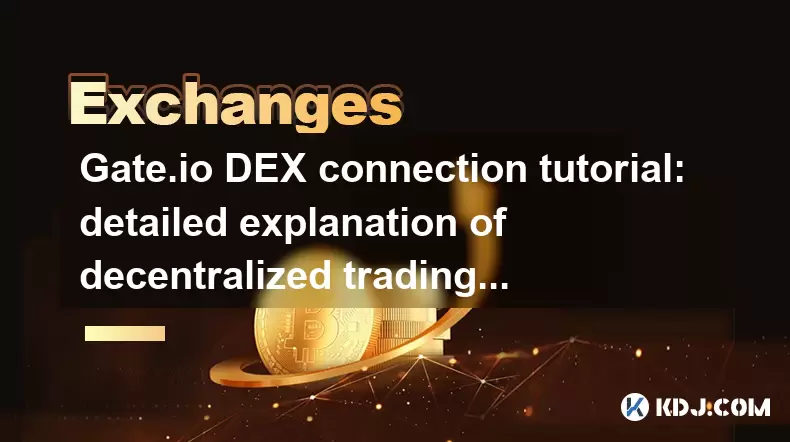
Gate.io DEX connection tutorial: detailed explanation of decentralized trading operation steps
Jun 12,2025 at 08:04pm
Connecting to Gate.io DEX: Understanding the BasicsBefore diving into the operational steps, it is crucial to understand what Gate.io DEX is and how it differs from centralized exchanges. Unlike traditional platforms where a central authority manages user funds and trades, Gate.io DEX operates on blockchain technology, allowing users to trade directly f...
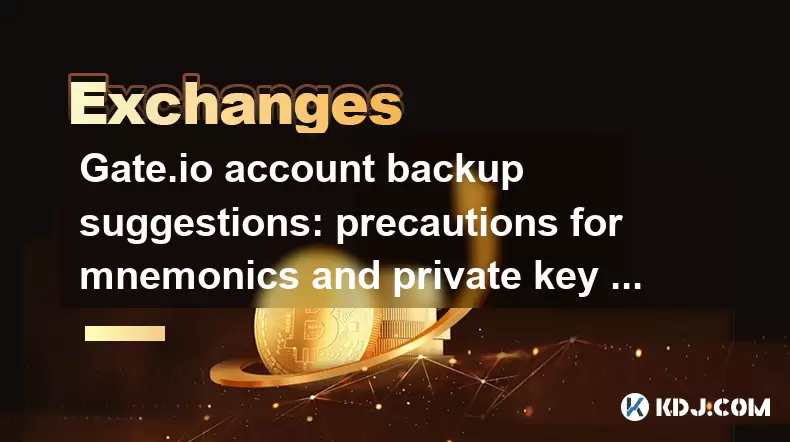
Gate.io account backup suggestions: precautions for mnemonics and private key storage
Jun 12,2025 at 10:56am
Understanding the Importance of Mnemonics and Private KeysIn the world of cryptocurrency, mnemonics and private keys are the core elements that grant users ownership over their digital assets. When using Gate.io or any other crypto exchange, understanding how to securely manage these components is crucial. A mnemonic phrase typically consists of 12 or 2...
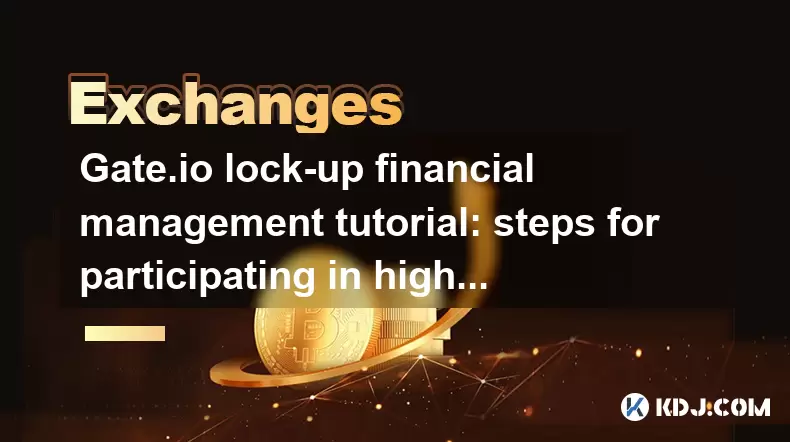
Gate.io lock-up financial management tutorial: steps for participating in high-yield projects and redemption
Jun 13,2025 at 12:43am
What Is Gate.io Lock-Up Financial Management?Gate.io is one of the world’s leading cryptocurrency exchanges, offering users a variety of financial products. Lock-up financial management refers to a type of investment product where users deposit their digital assets for a fixed period in exchange for interest or yield. These products are designed to prov...
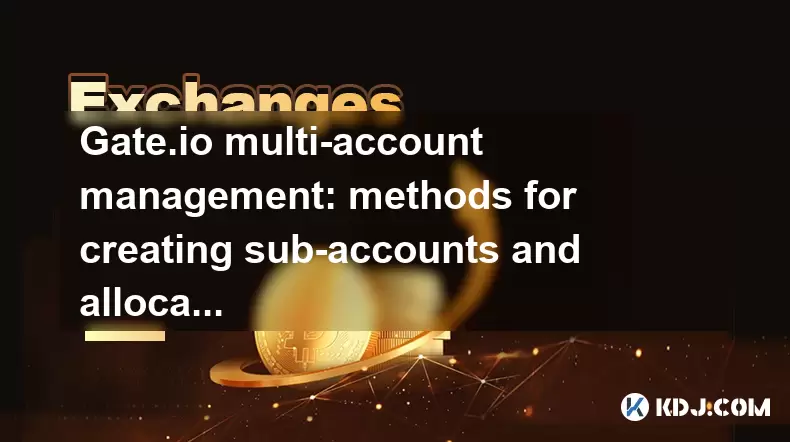
Gate.io multi-account management: methods for creating sub-accounts and allocating permissions
Jun 15,2025 at 03:42am
Creating Sub-Accounts on Gate.ioGate.io provides users with a robust multi-account management system that allows for the creation of sub-accounts under a main account. This feature is particularly useful for traders managing multiple portfolios or teams handling shared funds. To create a sub-account, log in to your Gate.io account and navigate to the 'S...
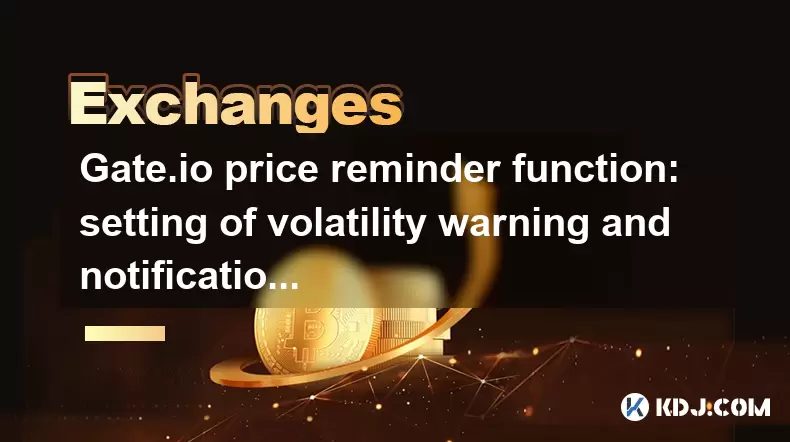
Gate.io price reminder function: setting of volatility warning and notification method
Jun 14,2025 at 06:35pm
What is the Gate.io Price Reminder Function?The Gate.io price reminder function allows users to set up custom price alerts for specific cryptocurrencies. This feature enables traders and investors to stay informed about significant price changes without constantly monitoring market data. Whether you're tracking a potential buy or sell opportunity, the p...

Gate.io trading pair management: tutorials on adding and deleting watchlists
Jun 16,2025 at 05:42am
What Is a Watchlist on Gate.io?A watchlist on Gate.io is a customizable feature that allows traders to monitor specific trading pairs without actively engaging in trades. This tool is particularly useful for users who want to track the performance of certain cryptocurrencies or trading pairs, such as BTC/USDT or ETH/BTC. By organizing frequently watched...

Gate.io DEX connection tutorial: detailed explanation of decentralized trading operation steps
Jun 12,2025 at 08:04pm
Connecting to Gate.io DEX: Understanding the BasicsBefore diving into the operational steps, it is crucial to understand what Gate.io DEX is and how it differs from centralized exchanges. Unlike traditional platforms where a central authority manages user funds and trades, Gate.io DEX operates on blockchain technology, allowing users to trade directly f...

Gate.io account backup suggestions: precautions for mnemonics and private key storage
Jun 12,2025 at 10:56am
Understanding the Importance of Mnemonics and Private KeysIn the world of cryptocurrency, mnemonics and private keys are the core elements that grant users ownership over their digital assets. When using Gate.io or any other crypto exchange, understanding how to securely manage these components is crucial. A mnemonic phrase typically consists of 12 or 2...

Gate.io lock-up financial management tutorial: steps for participating in high-yield projects and redemption
Jun 13,2025 at 12:43am
What Is Gate.io Lock-Up Financial Management?Gate.io is one of the world’s leading cryptocurrency exchanges, offering users a variety of financial products. Lock-up financial management refers to a type of investment product where users deposit their digital assets for a fixed period in exchange for interest or yield. These products are designed to prov...

Gate.io multi-account management: methods for creating sub-accounts and allocating permissions
Jun 15,2025 at 03:42am
Creating Sub-Accounts on Gate.ioGate.io provides users with a robust multi-account management system that allows for the creation of sub-accounts under a main account. This feature is particularly useful for traders managing multiple portfolios or teams handling shared funds. To create a sub-account, log in to your Gate.io account and navigate to the 'S...

Gate.io price reminder function: setting of volatility warning and notification method
Jun 14,2025 at 06:35pm
What is the Gate.io Price Reminder Function?The Gate.io price reminder function allows users to set up custom price alerts for specific cryptocurrencies. This feature enables traders and investors to stay informed about significant price changes without constantly monitoring market data. Whether you're tracking a potential buy or sell opportunity, the p...

Gate.io trading pair management: tutorials on adding and deleting watchlists
Jun 16,2025 at 05:42am
What Is a Watchlist on Gate.io?A watchlist on Gate.io is a customizable feature that allows traders to monitor specific trading pairs without actively engaging in trades. This tool is particularly useful for users who want to track the performance of certain cryptocurrencies or trading pairs, such as BTC/USDT or ETH/BTC. By organizing frequently watched...
See all articles
























